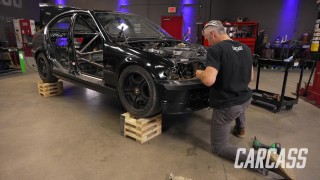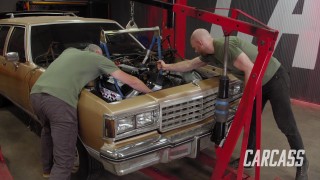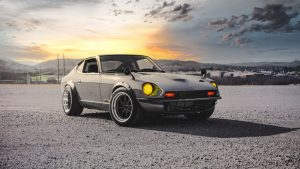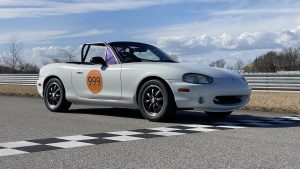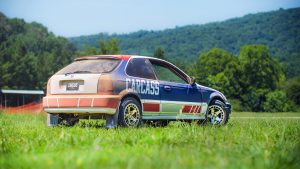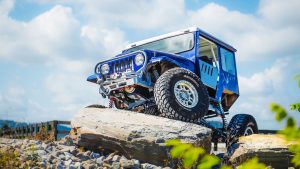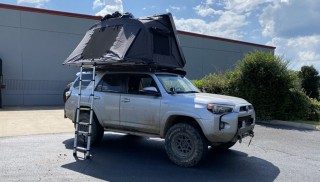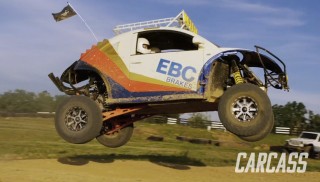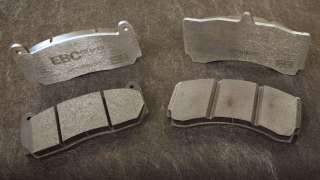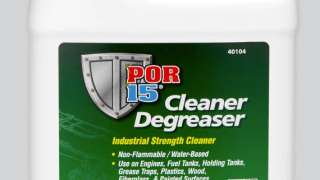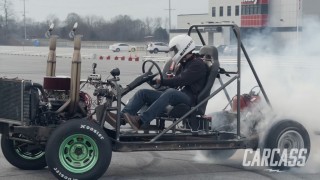Carcass Featured Projects
Carcass Builds
Want more content like this?
Join the PowerNation Email NewsletterEpisode Transcript
(Jimmy)>> You're watching Powernation!
(Jimmy)>> Today on Carcass we want the rear of our Camaro to stick to the track. So we'll need to replace the original shock mounts to accommodate our new full float nine inch rear end.
(Jeremy)>> Plus we'll mockup our upgraded braking system. Then we'll work on making our chassis more rigid for better handling. [ Music ] [ engine revving ] [ Music ]
(Jeremy)>> Hey everybody, welcome to Carcass! Well we have our 1972 Road Course Camaro up on the hoist today and we're gonna be tackling a couple different things. Up front we're gonna be working on the brakes. We're gonna be mocking up a big brake kit cause we definitely want to make sure Jimmy and I can handle this thing when it's out on the course. In the back since we mini tubbed the car we're running into a little bit of an issue, but Jimmy has a solution.
(Jimmy)>> And with the mini tubs in it to get them in there we had to cut off the stock shock mounts, and now we need a solution to re-mount them. The solution is to move them a little bit farther inboard. I'm gonna mount them up on this strong chassis section up here, and this will be plenty strong to handle the shock loads. That's one interesting thing to note here is that we have a leaf spring and a shock separate, whereas if you had a coil over you have spring and shock forces going through the same point. I took some measurements earlier here. So I have some files designed in cad already for the brackets up on this chassis rail and the brackets on the axle. So I'll head to the plasma table and get them cut out. [ torch hissing ]
(Jimmy)>> For the mounts we'll be using three-sixteenths pickled and oiled steel, which will be more than enough for the axle and chassis mounts. [ torch hissing ] [ Music ] [ torch hissing ] [ Music ]
(Jimmy)>> With the brackets cut out I'll do a little bit of prep work on the chassis and the axle to get them ready for welding. [ grinder buzzing ]
(Jimmy)>> I've got part of the chassis prepped for our shock mount brackets, and here's what we're working with. This top one is kind of a triangular based shape. I've got two holes for plug welds. One to just mount the shock, and it's gonna land up here. I'm not really sure where front to back yet because I want to get this bracket on the axle first. As you can see, our shock mount hole is placed quite a ways behind the centerline of the axle. So what I'll do here is get this tacked on the axle. I'll hand a plumb bob and make sure I hit dead center of the hole, and then I'll figure out where the center of this bracket should land on the chassis. [ welder crackling ] [ Music ]
(Jimmy)>> So as you can see, with the center mark on the chassis rail if I were to line up the center hole of my bracket it would put it right over this extra layer of sheet metal here, and I don't want to go through all the extra work of peeling that off just to weld a bracket onto this chassis rail. So if I just put it a little bit farther back it's gonna lean back our shock a little bit but it's still relatively straight up and down. So it's not going to affect the motion ratio much at all. So I'll just get this on here and we'll keep moving forward. [ welder crackling ]
(Jimmy)>> We'll just tack these in for now until we can get the axle out from under the car. [ welder crackling ] [ Music ]
(Jeremy)>> Dropped that one!
(Jimmy)>> Amateur! [ Music ]
(Jeremy)>> It's not heavy but it ain't light. Alright! [ Music ]
(Jimmy)>> With the axle removed I'll go ahead and fully weld the mounts to the axle. [ welder crackling ]
(Jimmy)>> That wraps up the welding on our axle. So now we can get this thing painted and put back in the car. The only thing left for me to do is weld on our shock brackets on the chassis. Then we can take a measurement and order our shocks.
(Jeremy)>> A race car needs to stop fast. So we'll help it out by installing a big brake kit.
(Jeremy)>> So like I said earlier, we're gonna be mocking up the brakes on our '72 Camaro and we got this setup from EBC Brakes. This is their Balanced Big Brake Kit with massive 355 millimeter two piece full floating rotors for the front, and their new six piston calipers. And in the rear we're gonna be running their 330 millimeter rotors and their four piston calipers. The calipers themselves are machined from a high temperature, low pressure casting, and they're just a whole lot better than your standard gravity fed castings. The rotor itself is a two piece design with a billet aluminum hat and a high carbon, high copper friction ring. So the way that we're gonna be setting up the brakes on the front of the Camaro is a little unique in the fact that we actually aren't running a stock spindle for a Camaro. This is a spindle from CPP, and it utilizes a C-5 Corvette hub, or unit bearing, out there. The reason why they do that is the pin on a stock spindle can actually move up and down with force, especially in racing. That force translates into brake pad knock bad. What brake pad knock back is when you have that pin move it can actually push the pads away from the rotor ever so slightly. So the next time you go to step on your brake pad you have a little bit of delay. Definitely don't want delay in your braking system especially when you're working on a race car or when you're out on the racetrack. So the solution for that was to run a hub like this. Speaking of this hub, this hub is set up for a C-5 Corvette, which means that this entire big brake kit is actually set up for a C-5 Corvette. The way that EBC kinda graphs all of this onto your C-5 is they have this billet aluminum adapter that just bolts right over to the hub, and in our case it bolts up to our spindle that we got from CPP. And then from here you take your new six piston caliper, and that just kinda all bolts right on after you get your rotor in place. This is all just for mockup at this point. So we've just got some random bolts that we're gonna be using to hold all this together, and another thing we did is when we ordered this hub this hub is from SKF. This is their X-tracker hub. This is 50 percent stiffer than you stock C-5 Corvette hub, and what that helps with is when we run a set of slicks on this car, or a wide set of tires, it's just gonna further decrease knock back. Again, this all just bolts on to the setup that we have on here now. So we'll go ahead and get the rotor on the car, get the pads and the caliper on, and we'll move on to the passenger side. [ Music ] [ metal clanging ]
[ Music ] So a couple more things to add on the brakes here. The color that's on the caliper itself, this is a hard anodized high temperature lacquer coating. This stuff is bottom than powder coating. The fact that is you put a whole bunch of heat cycle into your brake setup this stuff won't peal, or chip, or flake off, and on the rotor itself it's a two piece rotor. What that does is allows both the hat and the friction disc to expand at different rates. That allows your brakes to run a little more true, and that's a huge plus especially in the racing world, or even in your street driving world. So that pretty much buttons up the driver's side. Go ahead and start tackling the passenger side. For our brake pads EBC sent us their blue stuff pad that has a medium friction level compound, fast bed in times, and a linear performance curve. It's a great fit where lower friction is required to avoid wheel lock up. It's got superb pedal modulation with great fade resistance. Now these pads are exceptionally kind to your rotors. So for you guys that have a performance car that may have expensive two piece rotors this is the perfect fit for that. The pad compound is different than a semi-metallic pad, which may have really good stopping power but wear your rotors out a lot quicker. We got ours with this stainless steel backing instead of the blue backing. They're the perfect fit for our Camaro or for any of you guys that may have a daily driver that may see some spirited track day use. Now they're easy to install or replace. On our six piston caliper here all we did was remove the bridge, slide the pads in, put the bridge back in, slide our bolts in, we'll torque them down, and then when we're ready to hit the track all we've got to do is pump them up and hammer on the throttle.
(Jimmy)>> All metal surfaces need to be protected from the elements. We'll show you an easy way to keep your project parts looking great.
(Jeremy)>> So with the brakes all buttoned up on the front of the car we're gonna go ahead and make the car a roller again. And since Jimmy has the rear axle all buttoned up we're gonna add some coating to this before we slide it up underneath the Camaro. One thing we do want to do is tape this up before we apply any coating to it. We don't want any paint or any of that stuff inside the pumpkin here or on the snouts on the outside of this. So we'll go ahead and tape this up, hang it up, and get ready to spray. [ Music ] Taping everything up now will just save us a lot of time in the long run, especially when it comes time to cleaning everything up, and we move on to final assembly. [ Music ] A quick way to take care of the axle ends and the snouts is to use a combination of tape and paper. [ Music ]
[ Music ] Now the coating that we're gonna be putting on our rear axle housing is called POR-15. Some of you guys may call it poor-15, and before we taped it up I did take it outside. Then we hit it with our cleaner/degreaser, and I also sprayed it down with their metal prep to give it a good, solid etch. This stuff can be applied directly over rusted metal if it's prepped correctly, but it is a direct to metal coating. So it works perfectly for bare metal like our rear axle housing is currently. There is a couple of different ways you guys can lay this stuff down. You can use a paint brush or a foam brush. You can mix it up and put it into a spray gun, but you can also just get it in aerosol cans. The way that we're gonna do it is mix it up and put it in a spray gun. We're gonna be using the gloss black. So we'll go ahead and get into the mixing room, get this stuff mixed up, and we'll lay down a couple coats. [ Music ]
This system is used by automotive restoration professionals, off road enthusiasts, farming, and industrial equipment repair services. Their d-t-m topcoat is a direct to metal u/v resistant coating designed to work on prepped bare metal and work incredibly well in applications where there is a need to help preserve sub-straights susceptible to corrosion. The topcoat provides excellent adhesion, u/v protection, and is a permanent barrier to corrosion. [ fans humming ]
(Jeremy)>> So we have a really good coating on our axle, and it flowed out really nice, and one thing for you guys to note. If you're not gonna use this in a spray gun like we did, if you're gonna use it with a paint brush or a foam brush, you can get pretty much the same results. I've used this a lot in my older street rod building days, and we used to do both. We used to spray it and brush, and the results pretty much were the same. So we're gonna let this setup and cure for a little while. Then we'll get it down, get it all assembled back under the Camaro, and we're gonna make it a roller one more time.
(Jimmy)>> One really important aspect of any car project is the hardware that you put in it. Luckily for us our friends at ARP have us covered on our Camaro race car. Some particular areas of interest for us are the brakes, the suspension, and of course the engine. Two of the most commonly used materials around our shop are the stainless steel and the 87-40 chro-moly. Stainless steel is great in applications where you need some heat tolerance, resistance to rust and corrosion, and ARP stainless steel has a tensile strength of 170,000 p-s-i. If we need something a little bit stronger then we can turn to the 87-40 chro-moly. This has great fatigue properties, especially in racing applications, and it can be heat treated anywhere from 180,000 to 210,000 p-s-i. Speaking of our engine, if you guys haven't seen Pat and Frankie build this thing here's what they did. The guys down in EP started with a World Products Motown LS block that has a small block bottom end and accepts LS induction. After honing the cylinders and balancing the rotating assembly Pat and Frankie got busy dropping in a K-1 Technologies 43-40 forged crankshaft. Next the Wiseco forged pistons with Manley connecting rods and Summit Racing pistons rings were assembled. Then they were carefully placed into our block. They chose a custom ground cam from Comp Cams to give us a broad torque curve and good track manners. After the internals were complete a Jezel belt drive was set into place and the Moroso circle track dry sump oil pan was torqued down. The machined LME LS-7 based heads came next. These have a titanium intake valve with a 2.250 diameter, which allows for 400 c-f-m of flow and these heads yield a 13.9 to 1 compression ratio. The accessory drive is from Jones Racing, and it is customized to accept our Moroso five stage dry sump oil pump. Up top is an LME billet aluminum intake manifold, and to finish this engine off is a Holley Dominator e-c-u. All these goodies gave this 440 cubic inch engine great numbers on the dyno with an impressive 683 horsepower at 7,500 r-p-m and a peak torque of 551-pound feet. We can't wait to get this engine in our car, especially considering how much lighter this thing will be with all the carbon fiber components, but we do have a few more things to do before we can set it in there.
(Jeremy)>> Race cars need to be rigid and quick to respond. We stitch in a few gussets to stiffen up our chassis.
(Jimmy)>> We've been making some great progress on our Camaro Road Course Car, and there's another thing that I want to do to try to increase performance, and that's tying the body into the roll cage. I've already welded the main hoop to the body in the center of the car. So up front here I'm gonna tie in the A-pillar to the side hoop using a gusset. The biggest reason why we do this is because if we can stiffen up the body and the chassis we let the suspension actually do its job and it makes the car more predictable and hopefully lowers your lap time. This gusset I cut out on the plasma table, and I used a dimple dye to make these holes, but I'm gonna show you guys a way to do this without using any special tools outside of the dimple dye, and that all starts with using a manilla folder and taking some measurements. [ Music ]
[ Music ] All I'm trying to do here is get four measurements for the sides of our gusset. I laid a straight line down the roll cage tube to use as a reference. I can also use the A-pillar itself as a reference, and then for the top and the bottom edges I'm gonna make these parallel to each other. That way I don't have to worry about measuring this angle between the roll cage tube and the A-pillar. So now with my measurements I can just transfer them to my manilla folder, cut it out, and we'll have ourselves a template. I'll start by laying out a center line , the top and bottom lines, and then I'll fill in the sides. [ Music ]
[ Music ]
Try a little test fit here, and I did make this assuming this piece was symmetrical, which I know it's not. So we'll probably have to make an adjustment. If I line up this edge straight with the roll cage tube it looks like this lower corner can go in maybe an eighth of an inch. So I'll just draw a new line, trim it, and we'll re-test fit. [ Music ]
Now this thing is looking pretty good. It's nice and straight with the roll cage tube. It's mostly straight with the A-pillar. The A-pillar does bow a little bit. So it's not gonna be perfect, but this is good enough now that we can trace it out, trim it on some metal. [ Music ]
We're gonna be using 16-gauge steel for the gussets, which is a nice balance between being easy to work with and giving us some strength between the roll cage and the body. [ saw buzzing ] [ Music ] [ saw buzzing ] [ Music ]
(Jimmy)>> Now that I've got my piece cut out I'm actually gonna use the one that I've already made to figure out our hole spacing here. How far off the bottom, and then I'll make a center line and make a mark so we can drill a hole. Three and an eighth. [ Music ] [ hammer banging ] [ drill humming ]
(Jimmy)>> The hole saw size that you'll need depends on your dimple dye. So be sure to check with the manufacturer. [ saw buzzing ] [ mechanical humming ] [ Music ]
(Jimmy)>> These gussets often require some massaging to get them in, and having someone to help hold it in place can make it a lot easier. [ Music ]
[ Music ] Something I really like about these gussets is they give you some performance benefit and they look really cool too.
(Jeremy)>> Looks like you've got quite a bit of welding to do yet. I'm gonna do a little more cleaning, but that'll wrap it up for us. Until next time we'll see you guys later.
Show Full Transcript
(Jimmy)>> Today on Carcass we want the rear of our Camaro to stick to the track. So we'll need to replace the original shock mounts to accommodate our new full float nine inch rear end.
(Jeremy)>> Plus we'll mockup our upgraded braking system. Then we'll work on making our chassis more rigid for better handling. [ Music ] [ engine revving ] [ Music ]
(Jeremy)>> Hey everybody, welcome to Carcass! Well we have our 1972 Road Course Camaro up on the hoist today and we're gonna be tackling a couple different things. Up front we're gonna be working on the brakes. We're gonna be mocking up a big brake kit cause we definitely want to make sure Jimmy and I can handle this thing when it's out on the course. In the back since we mini tubbed the car we're running into a little bit of an issue, but Jimmy has a solution.
(Jimmy)>> And with the mini tubs in it to get them in there we had to cut off the stock shock mounts, and now we need a solution to re-mount them. The solution is to move them a little bit farther inboard. I'm gonna mount them up on this strong chassis section up here, and this will be plenty strong to handle the shock loads. That's one interesting thing to note here is that we have a leaf spring and a shock separate, whereas if you had a coil over you have spring and shock forces going through the same point. I took some measurements earlier here. So I have some files designed in cad already for the brackets up on this chassis rail and the brackets on the axle. So I'll head to the plasma table and get them cut out. [ torch hissing ]
(Jimmy)>> For the mounts we'll be using three-sixteenths pickled and oiled steel, which will be more than enough for the axle and chassis mounts. [ torch hissing ] [ Music ] [ torch hissing ] [ Music ]
(Jimmy)>> With the brackets cut out I'll do a little bit of prep work on the chassis and the axle to get them ready for welding. [ grinder buzzing ]
(Jimmy)>> I've got part of the chassis prepped for our shock mount brackets, and here's what we're working with. This top one is kind of a triangular based shape. I've got two holes for plug welds. One to just mount the shock, and it's gonna land up here. I'm not really sure where front to back yet because I want to get this bracket on the axle first. As you can see, our shock mount hole is placed quite a ways behind the centerline of the axle. So what I'll do here is get this tacked on the axle. I'll hand a plumb bob and make sure I hit dead center of the hole, and then I'll figure out where the center of this bracket should land on the chassis. [ welder crackling ] [ Music ]
(Jimmy)>> So as you can see, with the center mark on the chassis rail if I were to line up the center hole of my bracket it would put it right over this extra layer of sheet metal here, and I don't want to go through all the extra work of peeling that off just to weld a bracket onto this chassis rail. So if I just put it a little bit farther back it's gonna lean back our shock a little bit but it's still relatively straight up and down. So it's not going to affect the motion ratio much at all. So I'll just get this on here and we'll keep moving forward. [ welder crackling ]
(Jimmy)>> We'll just tack these in for now until we can get the axle out from under the car. [ welder crackling ] [ Music ]
(Jeremy)>> Dropped that one!
(Jimmy)>> Amateur! [ Music ]
(Jeremy)>> It's not heavy but it ain't light. Alright! [ Music ]
(Jimmy)>> With the axle removed I'll go ahead and fully weld the mounts to the axle. [ welder crackling ]
(Jimmy)>> That wraps up the welding on our axle. So now we can get this thing painted and put back in the car. The only thing left for me to do is weld on our shock brackets on the chassis. Then we can take a measurement and order our shocks.
(Jeremy)>> A race car needs to stop fast. So we'll help it out by installing a big brake kit.
(Jeremy)>> So like I said earlier, we're gonna be mocking up the brakes on our '72 Camaro and we got this setup from EBC Brakes. This is their Balanced Big Brake Kit with massive 355 millimeter two piece full floating rotors for the front, and their new six piston calipers. And in the rear we're gonna be running their 330 millimeter rotors and their four piston calipers. The calipers themselves are machined from a high temperature, low pressure casting, and they're just a whole lot better than your standard gravity fed castings. The rotor itself is a two piece design with a billet aluminum hat and a high carbon, high copper friction ring. So the way that we're gonna be setting up the brakes on the front of the Camaro is a little unique in the fact that we actually aren't running a stock spindle for a Camaro. This is a spindle from CPP, and it utilizes a C-5 Corvette hub, or unit bearing, out there. The reason why they do that is the pin on a stock spindle can actually move up and down with force, especially in racing. That force translates into brake pad knock bad. What brake pad knock back is when you have that pin move it can actually push the pads away from the rotor ever so slightly. So the next time you go to step on your brake pad you have a little bit of delay. Definitely don't want delay in your braking system especially when you're working on a race car or when you're out on the racetrack. So the solution for that was to run a hub like this. Speaking of this hub, this hub is set up for a C-5 Corvette, which means that this entire big brake kit is actually set up for a C-5 Corvette. The way that EBC kinda graphs all of this onto your C-5 is they have this billet aluminum adapter that just bolts right over to the hub, and in our case it bolts up to our spindle that we got from CPP. And then from here you take your new six piston caliper, and that just kinda all bolts right on after you get your rotor in place. This is all just for mockup at this point. So we've just got some random bolts that we're gonna be using to hold all this together, and another thing we did is when we ordered this hub this hub is from SKF. This is their X-tracker hub. This is 50 percent stiffer than you stock C-5 Corvette hub, and what that helps with is when we run a set of slicks on this car, or a wide set of tires, it's just gonna further decrease knock back. Again, this all just bolts on to the setup that we have on here now. So we'll go ahead and get the rotor on the car, get the pads and the caliper on, and we'll move on to the passenger side. [ Music ] [ metal clanging ]
[ Music ] So a couple more things to add on the brakes here. The color that's on the caliper itself, this is a hard anodized high temperature lacquer coating. This stuff is bottom than powder coating. The fact that is you put a whole bunch of heat cycle into your brake setup this stuff won't peal, or chip, or flake off, and on the rotor itself it's a two piece rotor. What that does is allows both the hat and the friction disc to expand at different rates. That allows your brakes to run a little more true, and that's a huge plus especially in the racing world, or even in your street driving world. So that pretty much buttons up the driver's side. Go ahead and start tackling the passenger side. For our brake pads EBC sent us their blue stuff pad that has a medium friction level compound, fast bed in times, and a linear performance curve. It's a great fit where lower friction is required to avoid wheel lock up. It's got superb pedal modulation with great fade resistance. Now these pads are exceptionally kind to your rotors. So for you guys that have a performance car that may have expensive two piece rotors this is the perfect fit for that. The pad compound is different than a semi-metallic pad, which may have really good stopping power but wear your rotors out a lot quicker. We got ours with this stainless steel backing instead of the blue backing. They're the perfect fit for our Camaro or for any of you guys that may have a daily driver that may see some spirited track day use. Now they're easy to install or replace. On our six piston caliper here all we did was remove the bridge, slide the pads in, put the bridge back in, slide our bolts in, we'll torque them down, and then when we're ready to hit the track all we've got to do is pump them up and hammer on the throttle.
(Jimmy)>> All metal surfaces need to be protected from the elements. We'll show you an easy way to keep your project parts looking great.
(Jeremy)>> So with the brakes all buttoned up on the front of the car we're gonna go ahead and make the car a roller again. And since Jimmy has the rear axle all buttoned up we're gonna add some coating to this before we slide it up underneath the Camaro. One thing we do want to do is tape this up before we apply any coating to it. We don't want any paint or any of that stuff inside the pumpkin here or on the snouts on the outside of this. So we'll go ahead and tape this up, hang it up, and get ready to spray. [ Music ] Taping everything up now will just save us a lot of time in the long run, especially when it comes time to cleaning everything up, and we move on to final assembly. [ Music ] A quick way to take care of the axle ends and the snouts is to use a combination of tape and paper. [ Music ]
[ Music ] Now the coating that we're gonna be putting on our rear axle housing is called POR-15. Some of you guys may call it poor-15, and before we taped it up I did take it outside. Then we hit it with our cleaner/degreaser, and I also sprayed it down with their metal prep to give it a good, solid etch. This stuff can be applied directly over rusted metal if it's prepped correctly, but it is a direct to metal coating. So it works perfectly for bare metal like our rear axle housing is currently. There is a couple of different ways you guys can lay this stuff down. You can use a paint brush or a foam brush. You can mix it up and put it into a spray gun, but you can also just get it in aerosol cans. The way that we're gonna do it is mix it up and put it in a spray gun. We're gonna be using the gloss black. So we'll go ahead and get into the mixing room, get this stuff mixed up, and we'll lay down a couple coats. [ Music ]
This system is used by automotive restoration professionals, off road enthusiasts, farming, and industrial equipment repair services. Their d-t-m topcoat is a direct to metal u/v resistant coating designed to work on prepped bare metal and work incredibly well in applications where there is a need to help preserve sub-straights susceptible to corrosion. The topcoat provides excellent adhesion, u/v protection, and is a permanent barrier to corrosion. [ fans humming ]
(Jeremy)>> So we have a really good coating on our axle, and it flowed out really nice, and one thing for you guys to note. If you're not gonna use this in a spray gun like we did, if you're gonna use it with a paint brush or a foam brush, you can get pretty much the same results. I've used this a lot in my older street rod building days, and we used to do both. We used to spray it and brush, and the results pretty much were the same. So we're gonna let this setup and cure for a little while. Then we'll get it down, get it all assembled back under the Camaro, and we're gonna make it a roller one more time.
(Jimmy)>> One really important aspect of any car project is the hardware that you put in it. Luckily for us our friends at ARP have us covered on our Camaro race car. Some particular areas of interest for us are the brakes, the suspension, and of course the engine. Two of the most commonly used materials around our shop are the stainless steel and the 87-40 chro-moly. Stainless steel is great in applications where you need some heat tolerance, resistance to rust and corrosion, and ARP stainless steel has a tensile strength of 170,000 p-s-i. If we need something a little bit stronger then we can turn to the 87-40 chro-moly. This has great fatigue properties, especially in racing applications, and it can be heat treated anywhere from 180,000 to 210,000 p-s-i. Speaking of our engine, if you guys haven't seen Pat and Frankie build this thing here's what they did. The guys down in EP started with a World Products Motown LS block that has a small block bottom end and accepts LS induction. After honing the cylinders and balancing the rotating assembly Pat and Frankie got busy dropping in a K-1 Technologies 43-40 forged crankshaft. Next the Wiseco forged pistons with Manley connecting rods and Summit Racing pistons rings were assembled. Then they were carefully placed into our block. They chose a custom ground cam from Comp Cams to give us a broad torque curve and good track manners. After the internals were complete a Jezel belt drive was set into place and the Moroso circle track dry sump oil pan was torqued down. The machined LME LS-7 based heads came next. These have a titanium intake valve with a 2.250 diameter, which allows for 400 c-f-m of flow and these heads yield a 13.9 to 1 compression ratio. The accessory drive is from Jones Racing, and it is customized to accept our Moroso five stage dry sump oil pump. Up top is an LME billet aluminum intake manifold, and to finish this engine off is a Holley Dominator e-c-u. All these goodies gave this 440 cubic inch engine great numbers on the dyno with an impressive 683 horsepower at 7,500 r-p-m and a peak torque of 551-pound feet. We can't wait to get this engine in our car, especially considering how much lighter this thing will be with all the carbon fiber components, but we do have a few more things to do before we can set it in there.
(Jeremy)>> Race cars need to be rigid and quick to respond. We stitch in a few gussets to stiffen up our chassis.
(Jimmy)>> We've been making some great progress on our Camaro Road Course Car, and there's another thing that I want to do to try to increase performance, and that's tying the body into the roll cage. I've already welded the main hoop to the body in the center of the car. So up front here I'm gonna tie in the A-pillar to the side hoop using a gusset. The biggest reason why we do this is because if we can stiffen up the body and the chassis we let the suspension actually do its job and it makes the car more predictable and hopefully lowers your lap time. This gusset I cut out on the plasma table, and I used a dimple dye to make these holes, but I'm gonna show you guys a way to do this without using any special tools outside of the dimple dye, and that all starts with using a manilla folder and taking some measurements. [ Music ]
[ Music ] All I'm trying to do here is get four measurements for the sides of our gusset. I laid a straight line down the roll cage tube to use as a reference. I can also use the A-pillar itself as a reference, and then for the top and the bottom edges I'm gonna make these parallel to each other. That way I don't have to worry about measuring this angle between the roll cage tube and the A-pillar. So now with my measurements I can just transfer them to my manilla folder, cut it out, and we'll have ourselves a template. I'll start by laying out a center line , the top and bottom lines, and then I'll fill in the sides. [ Music ]
[ Music ]
Try a little test fit here, and I did make this assuming this piece was symmetrical, which I know it's not. So we'll probably have to make an adjustment. If I line up this edge straight with the roll cage tube it looks like this lower corner can go in maybe an eighth of an inch. So I'll just draw a new line, trim it, and we'll re-test fit. [ Music ]
Now this thing is looking pretty good. It's nice and straight with the roll cage tube. It's mostly straight with the A-pillar. The A-pillar does bow a little bit. So it's not gonna be perfect, but this is good enough now that we can trace it out, trim it on some metal. [ Music ]
We're gonna be using 16-gauge steel for the gussets, which is a nice balance between being easy to work with and giving us some strength between the roll cage and the body. [ saw buzzing ] [ Music ] [ saw buzzing ] [ Music ]
(Jimmy)>> Now that I've got my piece cut out I'm actually gonna use the one that I've already made to figure out our hole spacing here. How far off the bottom, and then I'll make a center line and make a mark so we can drill a hole. Three and an eighth. [ Music ] [ hammer banging ] [ drill humming ]
(Jimmy)>> The hole saw size that you'll need depends on your dimple dye. So be sure to check with the manufacturer. [ saw buzzing ] [ mechanical humming ] [ Music ]
(Jimmy)>> These gussets often require some massaging to get them in, and having someone to help hold it in place can make it a lot easier. [ Music ]
[ Music ] Something I really like about these gussets is they give you some performance benefit and they look really cool too.
(Jeremy)>> Looks like you've got quite a bit of welding to do yet. I'm gonna do a little more cleaning, but that'll wrap it up for us. Until next time we'll see you guys later.







